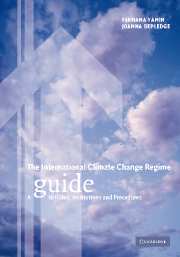Book contents
- Frontmatter
- Contents
- List of figures
- List of tables
- List of boxes
- Foreword by Joke Waller Hunter, Executive Secretary, FCCC
- Preface and acknowledgements
- List of abbreviations
- 1 Introduction
- 2 Overview
- 3 Regime participants
- 4 Objective and principles
- 5 Mitigation commitments
- 6 Flexibility mechanisms
- 7 Research, systematic observation, education, training and public awareness
- 8 Adaptation
- 9 Impacts of response measures
- 10 Finance, technology and capacity-building
- 11 Reporting and review
- 12 Compliance
- 13 Institutions
- 14 The negotiation process
- 15 Scientific and technical input
- 16 Administering the regime
- 17 Linkages
- 18 Evolution of the regime
- 19 Conclusion: taking stock and moving forward
- Appendix I List of Parties, their groups and key statistics
- Appendix II Annex I Party fact sheets: emissions, targets and projections for Annex I Parties and groupings
- Appendix III Table of Articles, issues and COP Decisions
- Bibliography
- Index
4 - Objective and principles
Published online by Cambridge University Press: 16 July 2009
- Frontmatter
- Contents
- List of figures
- List of tables
- List of boxes
- Foreword by Joke Waller Hunter, Executive Secretary, FCCC
- Preface and acknowledgements
- List of abbreviations
- 1 Introduction
- 2 Overview
- 3 Regime participants
- 4 Objective and principles
- 5 Mitigation commitments
- 6 Flexibility mechanisms
- 7 Research, systematic observation, education, training and public awareness
- 8 Adaptation
- 9 Impacts of response measures
- 10 Finance, technology and capacity-building
- 11 Reporting and review
- 12 Compliance
- 13 Institutions
- 14 The negotiation process
- 15 Scientific and technical input
- 16 Administering the regime
- 17 Linkages
- 18 Evolution of the regime
- 19 Conclusion: taking stock and moving forward
- Appendix I List of Parties, their groups and key statistics
- Appendix II Annex I Party fact sheets: emissions, targets and projections for Annex I Parties and groupings
- Appendix III Table of Articles, issues and COP Decisions
- Bibliography
- Index
Summary
This chapter explains two foundational elements of the climate regime: its ‘ultimate objective’ as set out in Article 2 of the Convention and its principles, set out mainly in Article 3 of the Convention. Although Articles 2 and 3 intentionally do not establish concrete commitments for individual Parties, their constraining influence on the regime as a whole is palpable at many levels. In broad terms, Article 2 provides overall guidance for the basic values and scientific orientation for the climate regime whilst Article 3 provides guidance bearing more directly on implementation of the commitments Parties have accepted under the regime and their evolution. For these reasons, the implications of Article 2 are the focus of particular attention among scientists, policy-makers and stakeholders as climate policy-makers begin to grapple with the issue of defining what constitutes ‘dangerous anthropogenic interference with the climate system’. The implications of the principles set out in Article 3 are also topical as policy-makers attempt to work out the potential implications of these principles for the design of the future climate regime, including who, when and in relation to what additional commitments should be formulated. This section explains Articles 2 and 3, providing in each case an analysis of their implications, additional information about their historical development, current legal status and practical illustrations of their significance to the current policy context.
Ultimate objective
Nature and scope
The Convention establishes an objective for its Parties: the ‘stabilization of greenhouse gas concentrations in the atmosphere at a level that would prevent dangerous anthropogenic interference with the climate system’.
- Type
- Chapter
- Information
- The International Climate Change RegimeA Guide to Rules, Institutions and Procedures, pp. 60 - 73Publisher: Cambridge University PressPrint publication year: 2004



